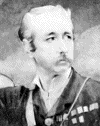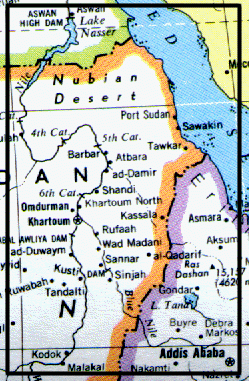
The First and Only Weekly Online Fanzine Devoted to the Life and Works of Edgar Rice Burroughs |
 |

The First and Only Weekly Online Fanzine Devoted to the Life and Works of Edgar Rice Burroughs |
 |
Nkima's Chat # 18
A Search for the Lost Cities
of Rome:
Castrum Mare and Castra Sanguinarius
By David Adams

![]()
| In Edgar Rice Burroughs’ “Tarzan
and the Lost Empire” Erich von Harben is found living among
a legendary lost tribe of white men, which turns out to be the lost Roman
outpost of Castrum Mare deep within the Wiramwazi Mountains
of Africa. The inhabitants of this city are the eternal foes of yet
another city, Castra Sanguinarius, which lies nearby a little to
the west.
Castrum Mare was founded in the Roman year 935 (A.D. 200) by Honus Hasta, a patrician of Castra Sanguinarius, who was disgusted with the high crime rate there and wished to make a change. Castra Sanguinarius was founded earlier in the 853rd year of Rome by praefect Marcus Crispus Sanguinarius, who was fleeing for his life with an entire cohort of Roman legionnaires. |
| I believe we may safely assume that the Wiramwazi mountains
of Burroughs are actually the Ruwenzori, the famous “Mountains
of the Moon” that lie along the chain of lakes between Uganda and
the Congo. This is indeed “Tarzan’s country” that Dr. von Harben
arrives at searching for his son who has disappeared into the mountains.
(TLE, 6).
If Sanguinarius actually traveled up the White Nile to the Ruwenzori range, it was an epic journey almost beyond belief. He would have had to push up the Nile all the way from Thebes in Egypt through the nearly impassible difficulties of the Sudan to reach Uganda. It is a journey that he is unlikely to have made with a cohort of nearly 500 men with perhaps an equal number of women captured with the caravan of great riches. |
| I propose that there is a more likely location for the twin Roman cities a little further from Tarzan stomping grounds, a place that is mentioned by ERB in his Tarzan and the City of Gold. As the author so aptly put it, “Wanderer, adventurer, outcast, Greek phalanx, and Roman legion, all have entered Abyssinia within times chronicled in history or legend never to reappear; and it is even believed by some that she holds the secret of the lost tribes of Israel.” (TCG, 12). Indeed, these “lost tribes of biblical history” are mentioned by Dr. von Harben on page 8 of “Tarzan and the Lost Empire,” perhaps providing us with another clue to their actual location |
![]()
Tracing the Route of Sanguinarius
![]()
| ERB tells us that Sanguinarius, a praefect of the Third Cohort of the
Tenth Legion, was stationed below Thebae in Aegyptus.
[See my article in the Burroughs Bulletin #42, Spring 2000 on the true number of this legion -- “Fabulous Tales from a Papyrus Scroll: Tarzan and the Lost Empire.” This article is also reprinted by Tangor at “Nkima Speaks.”] This post was not a plumb in the first place because he was sweltering in Upper Egypt while the rest of the legion was posted at Nicopolis on the Mediterranean seacoast at Alexandria. “The two Egyptian legions (III Cyrenaica and XXII Deiotariana) was concentrated in one camp at Nicopolis, which they continued to occupy despite Domitian’s regulation till at least 119 A.D.” (Parker, 194).
|
|
The name “Nikopolis” means Victory-town, which was really a euphemism for “the army camp that holds Egypt under its Roman thumb.” Like all Roman constructions it was quite a place, shiny new buildings with an amphitheater, a stadium -- the Gymnasian, with porticoes more than a stadioin in length -- a Court of Justice and the Groves. Alexandria was a great place to live with its Harbour, Museum, palaces and public walks. Sanguinarius was not well-off up the river in Thebes. (Lindsay, 18-19). When Sanguinarius was called back to Rome under arrest, he convinced his cohort to escape on foot up the Nile. As they were starting out they happened to meet a caravan carrying hundreds of slaves from India and far Cathay, most of them young girls, which were captured because it was the thing a bunch of deserting soldiers would do coming upon so many beautiful women, but the slaves eventually became the breeding stock of their new city. ERB tells us that the caravan had landed at Myos-hormos, a port of Aegyptus on the Sinus Arabius. This port was probably the present day, Hurghada, which lies near Thebes, or perhaps it was Qusier, which lies a little closer. There are not that many seaports near Thebes, so the capture of the caravan was a real stroke of luck. Burroughs tells us that Sanguinarius and his fleeing party settled several times over the next five years in what they hoped would prove a permanent camp. They discovered the hidden canyon where they founded Castra Sanguinarius quite by accident. (Burroughs, 149). After the deserting soldiers captured the caravan, they obviously killed everyone except the women, and had a large number of camels and horses to help with transportation. ERB tells us that the fleet that landed at the port consisted of 120 vessels, so the caravan had to have been a large one to transport the hundreds of slaves along with the gold, pearls, diamonds, and a variety of aromatics and other merchandise. The loss of this caravan had to have been a considerable economic blow to the Romans and Egyptians alike, so it was likely that they were followed. My guess is that the raid took place somewhere near Qus, and the party set out into the desert almost immediately near the temples at Luxor rather than remaining on the main road up the Nile. They may have made a quick raid into Aswan before heading out into the Nubian Desert of the Sudan, and they most likely continued these raids along the seacoast until they reached the mountains of Ethiopia |

|
This journey up the Nile with a large body of soldiers was precisely
the problem that faced General
Garnet Wolseley in September of 1884. He was sent by Gladstone’s
government to relieve General
George “Chinese” Gordon, who was besieged by Muhammad Ahmad, “the Mahdi,”
at Khartoum. Of course, Wolseley failed in his mission partly because
he chose to follow the Nile which winds through the Sudan
over many dangerous cataracts.
Wolseley’s mistake was trying to move 11,000 troops up the Nile in hundreds of small whalers, suitable for rowing or sailing, when the obvious route suggested by most tacticians was inland from Suakin through Berber, thence to Khartoum. Any commander worth his salt could tell that the way through the desert was the quickest passage, and Sanguinarius was a military man in a hurry. (Boyles, 71). |
 |
I just can’t believe that Sanguinarius would have traveled the torturous,
winding road up the Nile to Khartoum, then have chosen the White
Nile route, which leads even further away from the sea. It seems
certain that even if he did chose this route that by the time he reached
Malakal,
far south of Khartoum, he would have found the way impassable as
did Nero’s earlier explorers.
Nero sent an expedition into central Africa around 61 A.D. They got as far as the Sudd, an impassable swamp. “The African expedition, which may have started out from Rome in 61, consisted of a small party of Praetorian guardsmen including perhaps two officers. After sailing to Egypt, they crossed the southern frontier of the empire near the First Cataract, this side of the present Egyptian-Sudanese border. Then they proceeded south into the Sudan. They passed the Nile’s junction with the Atbara and reached Meroe (Bakarawiga) capital of Napata -- an independent state, with which Rome maintained a connection. |
| Here the Napatans provided them with a military escort, and they moved
southwards once again. Finally they came to immense marshes, where
they saw plants so ‘entangled with waters’ that they were impenetrable,
except perhaps for a one-man canoe. This description clearly indicates
the Sudd, the marshy area of floating islands of vegetation on the
White
Nile south of Malakal, in the Upper Nile province of the Sudan --
a region not rediscovered until 1839-40.
Nero’s explorers had penetrated 1,000 miles beyond the imperial frontier, as the crow flies -- in reality, of course, their journey had been a very great deal longer. When they finally got home again, they were interviewed by Seneca, who listened to their stories of parakeets, rhinoceroses, elephants, dog-faced baboons -- and, for good measure, dog-faced men as well.” (Grant, 98-99). Moving a party of nearly a thousand people through impassable swamps on one-man canoes does not seem like the likely course of a Roman commander with hundreds of camels and a great treasure on board. Sudd is an Arabic word meaning “obstacle” or “blockage,” and indeed it was the major obstacle to discovering the source of the Nile by simply sailing up river. Brueckel and Harwood, who are the experts in locating ERB’s lost cities, place the lost “Greek” cities of Athne and Cathne in Ethiopia “in the high mountains just east of the string of lakes between Adis Ababa and Lake Rudolph” (Brueckel, 45). |
| My placement of the Roman cities in Ethiopia as well does
not seem to be far off the track from a logical geographical and military
standpoint. Even if Sanguinarius did not head out into the desert
immediately after capturing the caravan, the Blue Nile route into
Ethiopia
could be easily followed after the splitting of the river at Khartoum.
In any case, I believe that Sanguinarius soon found himself wandering in the northern mountains of Ethiopia until he finally founded his city perhaps somewhere near the location of Athne and Cathne in the hidden valleys of that country. When von Harben came to the valley of the Roman cities he had to descend into “a great abyss” -- a mighty canyon similar to that which has made the gorge of the Colorado world-famous” (Burroughs. Lost Empire, 20). Ethiopia is part of the East African Rift Plateau. Millennia of erosion have produced steep valleys, in places 1,600 meters deep and several kilometers wide. As in the legend of Prester John, who may also have lived in Ethiopia, the final resting place of the lost Roman legion must remain a mystery. However, if this little essay brings you a little closer to Tarzan and The Lost Empire by Edgar Rice Burroughs, don’t thank me, thank little Nkima |
![]()
Bibliography
![]()
Boyles, Denis, African Lives, Weidenfeld & Nicolson, 1988.
Brueckel, Frank J. and Harwood, John, Heritage of the Flaming God, Waziri Publications, 1999.
Burroughs, Edgar Rice, Tarzan and the Lost Empire, ERB, 1929.
--------------, Tarzan and the City of Gold.
Grant, Michael, Nero, Folio Society, 1999.
James Bruce, Early Explorer of Africa:
http://www.robinsonresearch.com/AFRICA/HISTORY/Bruce.htm
Kelsey, D.M. Stanley and the White Heroes in Africa, Wolfe Publishing Co. Inc., 1988.
Lindsay, Jack, Cleopatra, The Folio Society, 1999.
Sterling, Thomas, Exploration of Africa, Horizon Caravel, Harper & Row, 1963.
Parker, H.M.D. The Roman Legions, W. Heffer and Sons, 1958.
Visit
ERBzine
0396:
for
a complete list of Nkima's other
Chattering
From The Shoulder columns
David Adams
![]()
![]()
Volume
0451
![]()

![]()
BILL
HILLMAN
Visit
our thousands of other sites at:
BILL
AND SUE-ON HILLMAN ECLECTIC STUDIO
All
ERB Images© and Tarzan® are Copyright ERB, Inc.- All Rights Reserved.
All
Original Work © 1996-2004/2010 by Bill Hillman and/or Contributing
Authors/Owners
No
part of this web site may be reproduced without permission from the respective
owners.